Analysis of Economic Principles and Impacts in Peru and Australia
VerifiedAdded on 2020/05/04
|8
|1343
|37
AI Summary
The document explores key economic principles focusing on the consequences of tax-free housing in Lima, Peru, which leads to the accumulation of unrecognized property or 'dead capital', impacting the poor negatively. It further analyzes the structure of informal economies, particularly in Botswana and Peru, highlighting their characteristics and implications on economic growth. The discussion also extends to Australia's response to the 2008 Global Financial Crisis using macroeconomic tools such as the AD AS framework, illustrating how strategic policies maintained stability despite global downturns.
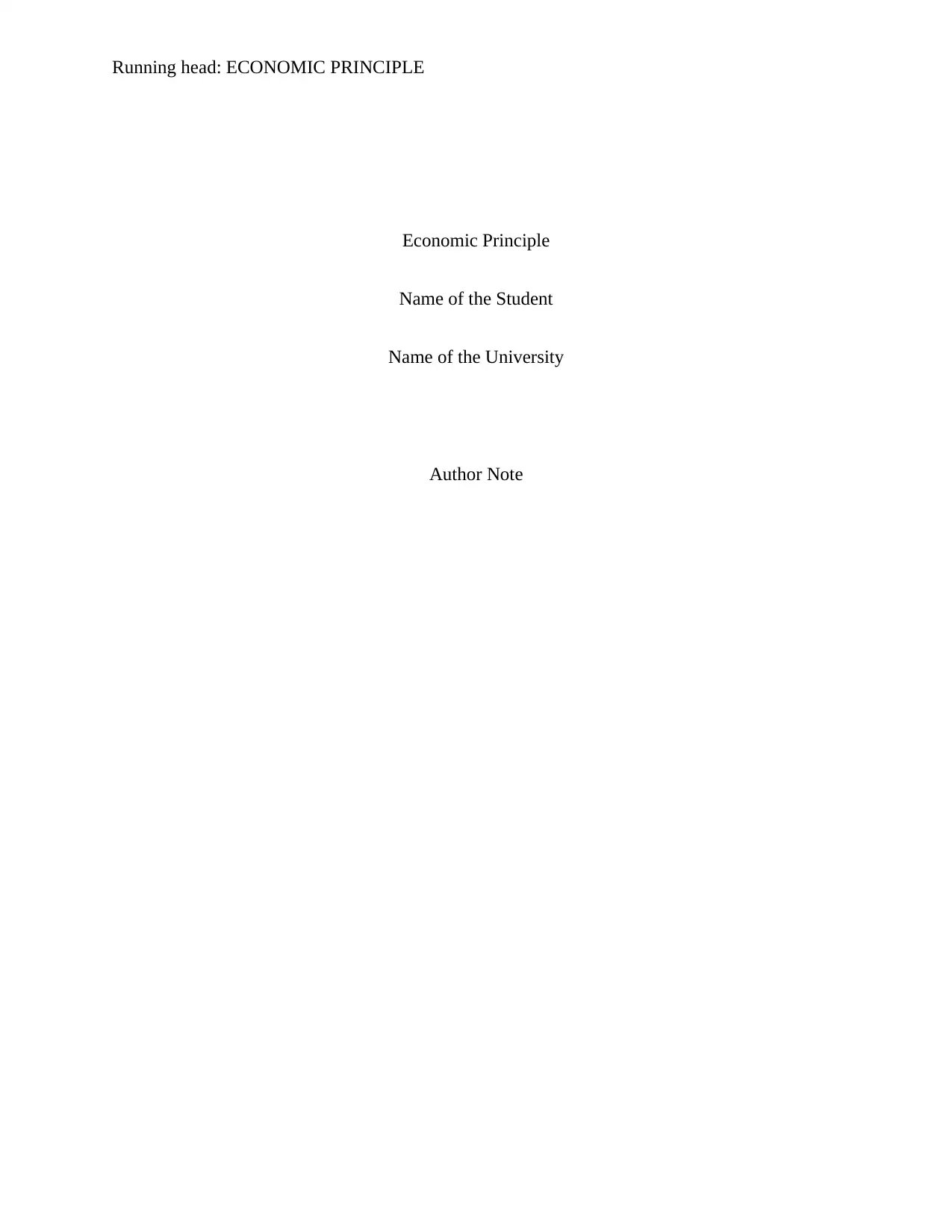
Running head: ECONOMIC PRINCIPLE
Economic Principle
Name of the Student
Name of the University
Author Note
Economic Principle
Name of the Student
Name of the University
Author Note
Paraphrase This Document
Need a fresh take? Get an instant paraphrase of this document with our AI Paraphraser
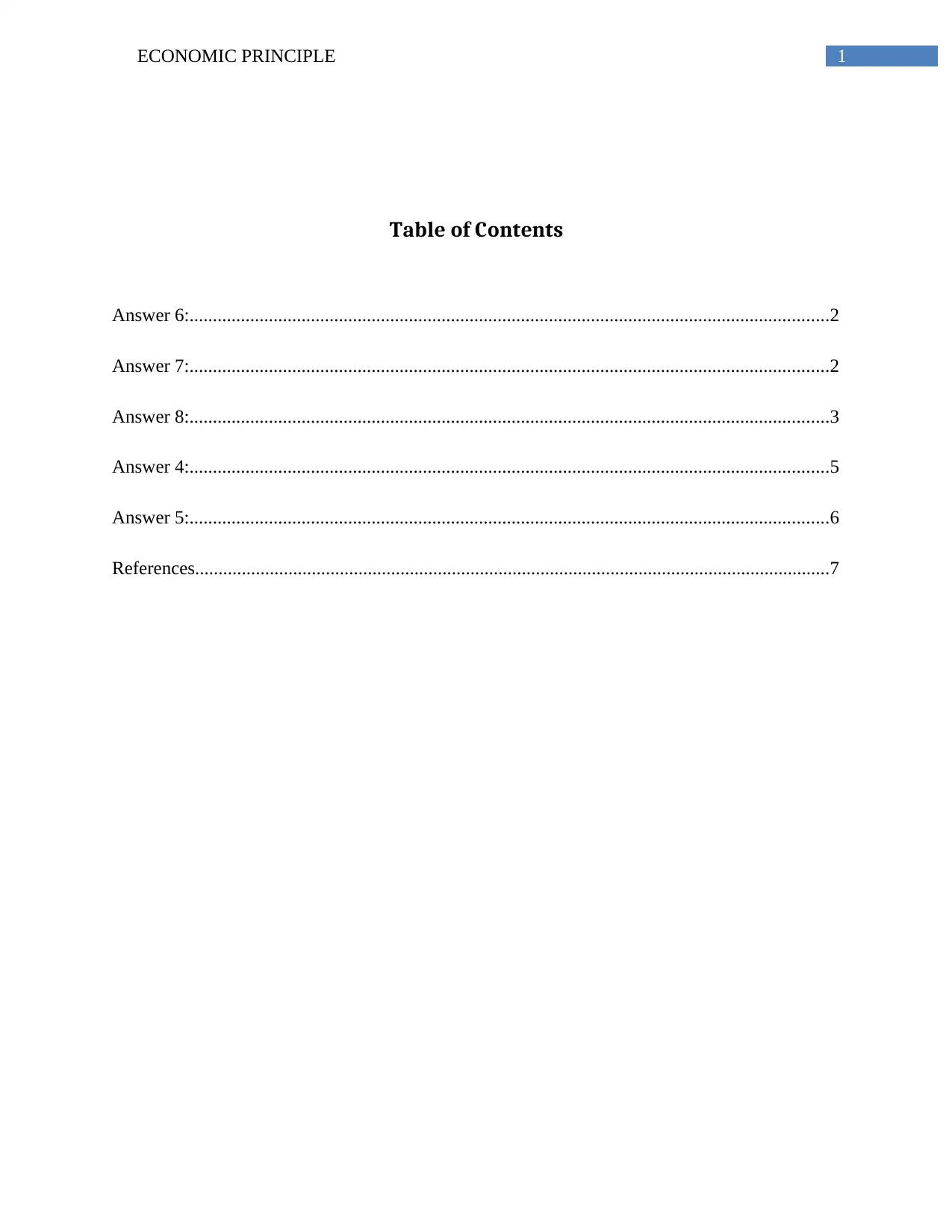
1ECONOMIC PRINCIPLE
Table of Contents
Answer 6:.........................................................................................................................................2
Answer 7:.........................................................................................................................................2
Answer 8:.........................................................................................................................................3
Answer 4:.........................................................................................................................................5
Answer 5:.........................................................................................................................................6
References........................................................................................................................................7
Table of Contents
Answer 6:.........................................................................................................................................2
Answer 7:.........................................................................................................................................2
Answer 8:.........................................................................................................................................3
Answer 4:.........................................................................................................................................5
Answer 5:.........................................................................................................................................6
References........................................................................................................................................7
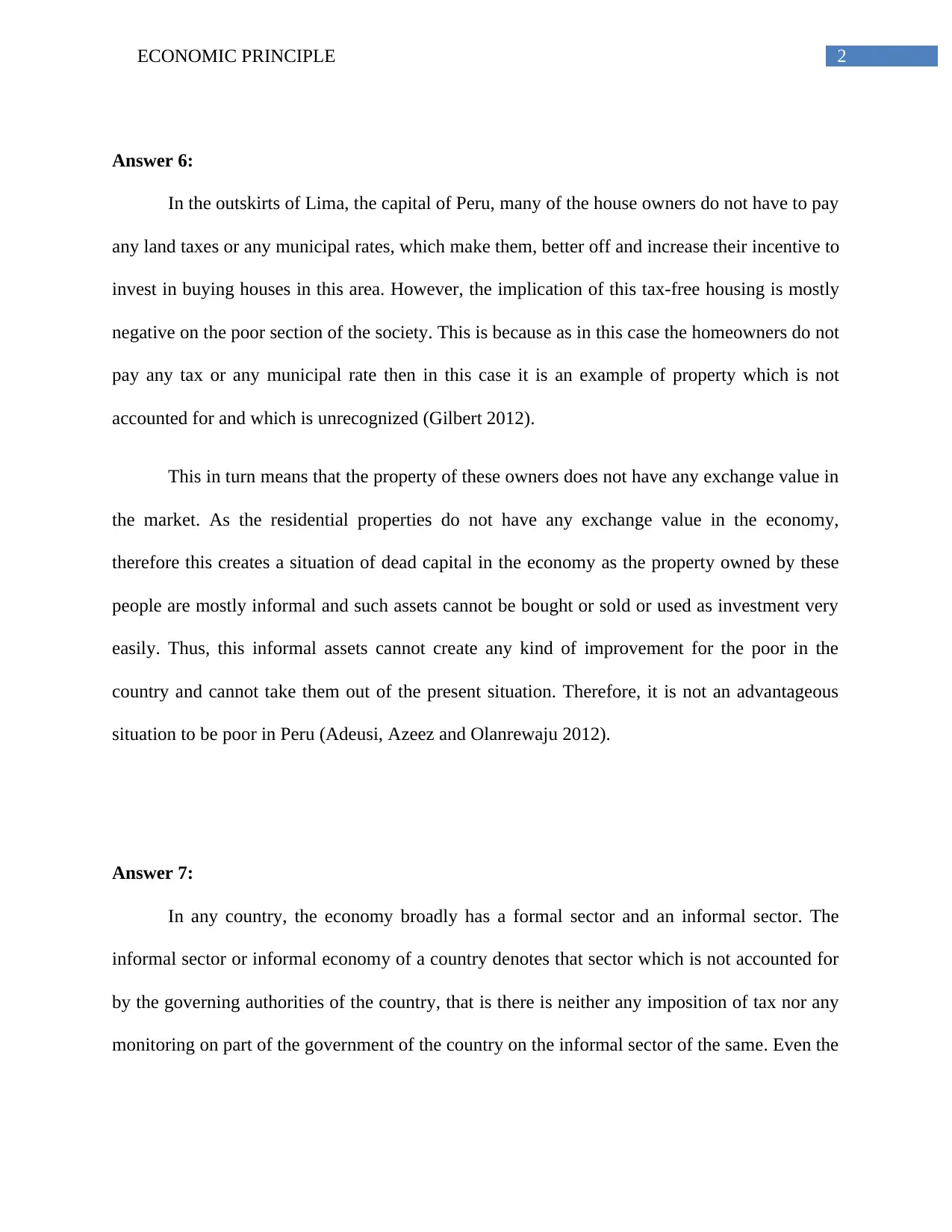
2ECONOMIC PRINCIPLE
Answer 6:
In the outskirts of Lima, the capital of Peru, many of the house owners do not have to pay
any land taxes or any municipal rates, which make them, better off and increase their incentive to
invest in buying houses in this area. However, the implication of this tax-free housing is mostly
negative on the poor section of the society. This is because as in this case the homeowners do not
pay any tax or any municipal rate then in this case it is an example of property which is not
accounted for and which is unrecognized (Gilbert 2012).
This in turn means that the property of these owners does not have any exchange value in
the market. As the residential properties do not have any exchange value in the economy,
therefore this creates a situation of dead capital in the economy as the property owned by these
people are mostly informal and such assets cannot be bought or sold or used as investment very
easily. Thus, this informal assets cannot create any kind of improvement for the poor in the
country and cannot take them out of the present situation. Therefore, it is not an advantageous
situation to be poor in Peru (Adeusi, Azeez and Olanrewaju 2012).
Answer 7:
In any country, the economy broadly has a formal sector and an informal sector. The
informal sector or informal economy of a country denotes that sector which is not accounted for
by the governing authorities of the country, that is there is neither any imposition of tax nor any
monitoring on part of the government of the country on the informal sector of the same. Even the
Answer 6:
In the outskirts of Lima, the capital of Peru, many of the house owners do not have to pay
any land taxes or any municipal rates, which make them, better off and increase their incentive to
invest in buying houses in this area. However, the implication of this tax-free housing is mostly
negative on the poor section of the society. This is because as in this case the homeowners do not
pay any tax or any municipal rate then in this case it is an example of property which is not
accounted for and which is unrecognized (Gilbert 2012).
This in turn means that the property of these owners does not have any exchange value in
the market. As the residential properties do not have any exchange value in the economy,
therefore this creates a situation of dead capital in the economy as the property owned by these
people are mostly informal and such assets cannot be bought or sold or used as investment very
easily. Thus, this informal assets cannot create any kind of improvement for the poor in the
country and cannot take them out of the present situation. Therefore, it is not an advantageous
situation to be poor in Peru (Adeusi, Azeez and Olanrewaju 2012).
Answer 7:
In any country, the economy broadly has a formal sector and an informal sector. The
informal sector or informal economy of a country denotes that sector which is not accounted for
by the governing authorities of the country, that is there is neither any imposition of tax nor any
monitoring on part of the government of the country on the informal sector of the same. Even the
⊘ This is a preview!⊘
Do you want full access?
Subscribe today to unlock all pages.

Trusted by 1+ million students worldwide
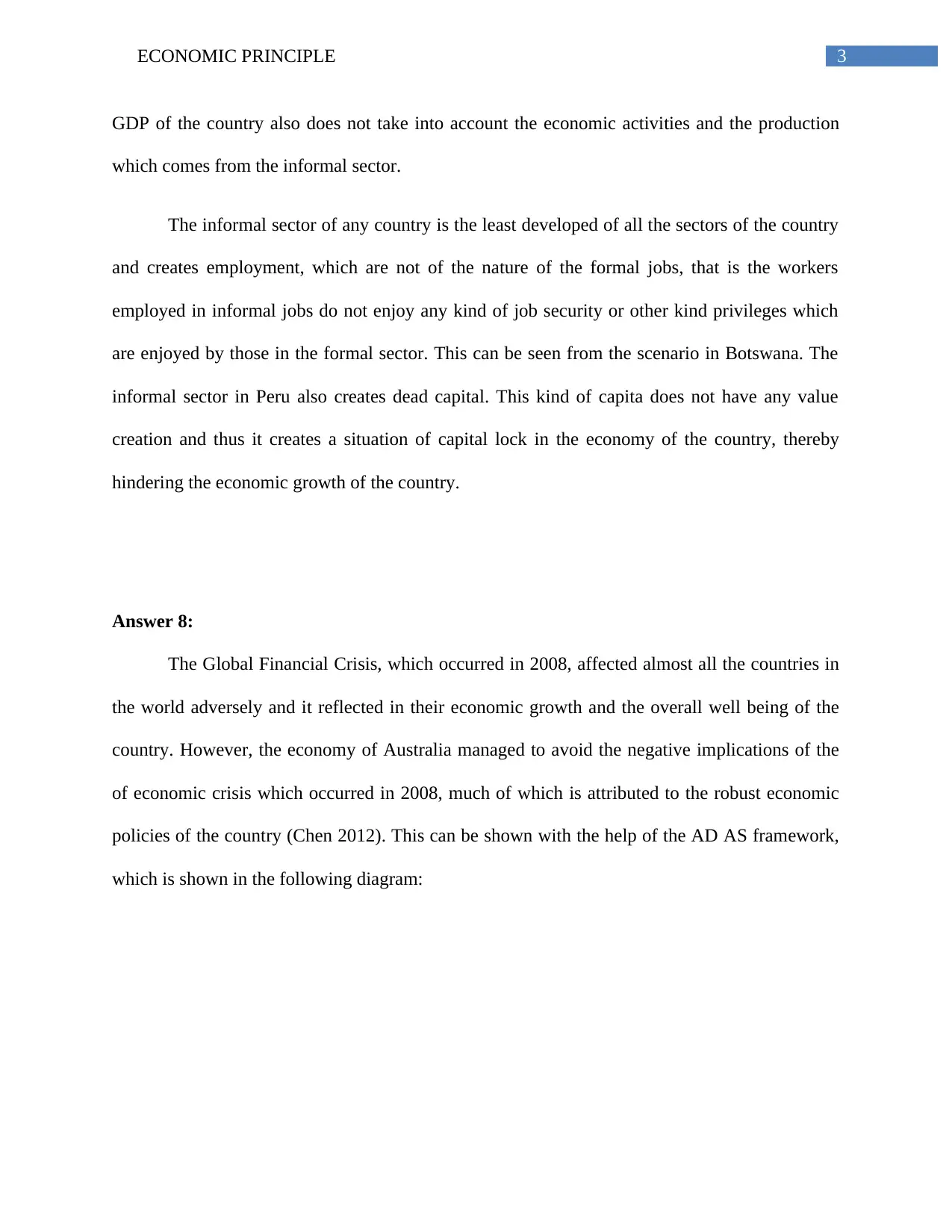
3ECONOMIC PRINCIPLE
GDP of the country also does not take into account the economic activities and the production
which comes from the informal sector.
The informal sector of any country is the least developed of all the sectors of the country
and creates employment, which are not of the nature of the formal jobs, that is the workers
employed in informal jobs do not enjoy any kind of job security or other kind privileges which
are enjoyed by those in the formal sector. This can be seen from the scenario in Botswana. The
informal sector in Peru also creates dead capital. This kind of capita does not have any value
creation and thus it creates a situation of capital lock in the economy of the country, thereby
hindering the economic growth of the country.
Answer 8:
The Global Financial Crisis, which occurred in 2008, affected almost all the countries in
the world adversely and it reflected in their economic growth and the overall well being of the
country. However, the economy of Australia managed to avoid the negative implications of the
of economic crisis which occurred in 2008, much of which is attributed to the robust economic
policies of the country (Chen 2012). This can be shown with the help of the AD AS framework,
which is shown in the following diagram:
GDP of the country also does not take into account the economic activities and the production
which comes from the informal sector.
The informal sector of any country is the least developed of all the sectors of the country
and creates employment, which are not of the nature of the formal jobs, that is the workers
employed in informal jobs do not enjoy any kind of job security or other kind privileges which
are enjoyed by those in the formal sector. This can be seen from the scenario in Botswana. The
informal sector in Peru also creates dead capital. This kind of capita does not have any value
creation and thus it creates a situation of capital lock in the economy of the country, thereby
hindering the economic growth of the country.
Answer 8:
The Global Financial Crisis, which occurred in 2008, affected almost all the countries in
the world adversely and it reflected in their economic growth and the overall well being of the
country. However, the economy of Australia managed to avoid the negative implications of the
of economic crisis which occurred in 2008, much of which is attributed to the robust economic
policies of the country (Chen 2012). This can be shown with the help of the AD AS framework,
which is shown in the following diagram:
Paraphrase This Document
Need a fresh take? Get an instant paraphrase of this document with our AI Paraphraser
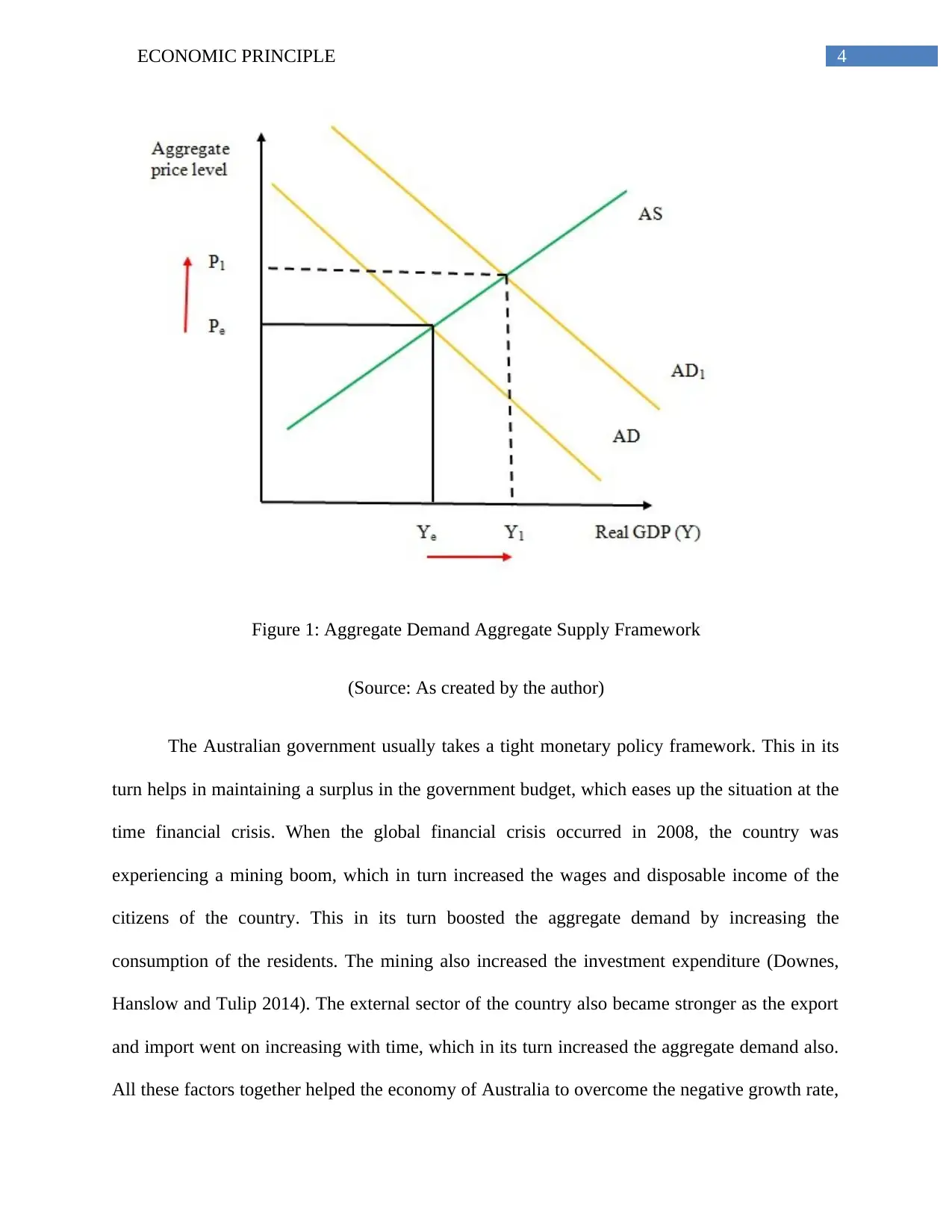
4ECONOMIC PRINCIPLE
Figure 1: Aggregate Demand Aggregate Supply Framework
(Source: As created by the author)
The Australian government usually takes a tight monetary policy framework. This in its
turn helps in maintaining a surplus in the government budget, which eases up the situation at the
time financial crisis. When the global financial crisis occurred in 2008, the country was
experiencing a mining boom, which in turn increased the wages and disposable income of the
citizens of the country. This in its turn boosted the aggregate demand by increasing the
consumption of the residents. The mining also increased the investment expenditure (Downes,
Hanslow and Tulip 2014). The external sector of the country also became stronger as the export
and import went on increasing with time, which in its turn increased the aggregate demand also.
All these factors together helped the economy of Australia to overcome the negative growth rate,
Figure 1: Aggregate Demand Aggregate Supply Framework
(Source: As created by the author)
The Australian government usually takes a tight monetary policy framework. This in its
turn helps in maintaining a surplus in the government budget, which eases up the situation at the
time financial crisis. When the global financial crisis occurred in 2008, the country was
experiencing a mining boom, which in turn increased the wages and disposable income of the
citizens of the country. This in its turn boosted the aggregate demand by increasing the
consumption of the residents. The mining also increased the investment expenditure (Downes,
Hanslow and Tulip 2014). The external sector of the country also became stronger as the export
and import went on increasing with time, which in its turn increased the aggregate demand also.
All these factors together helped the economy of Australia to overcome the negative growth rate,
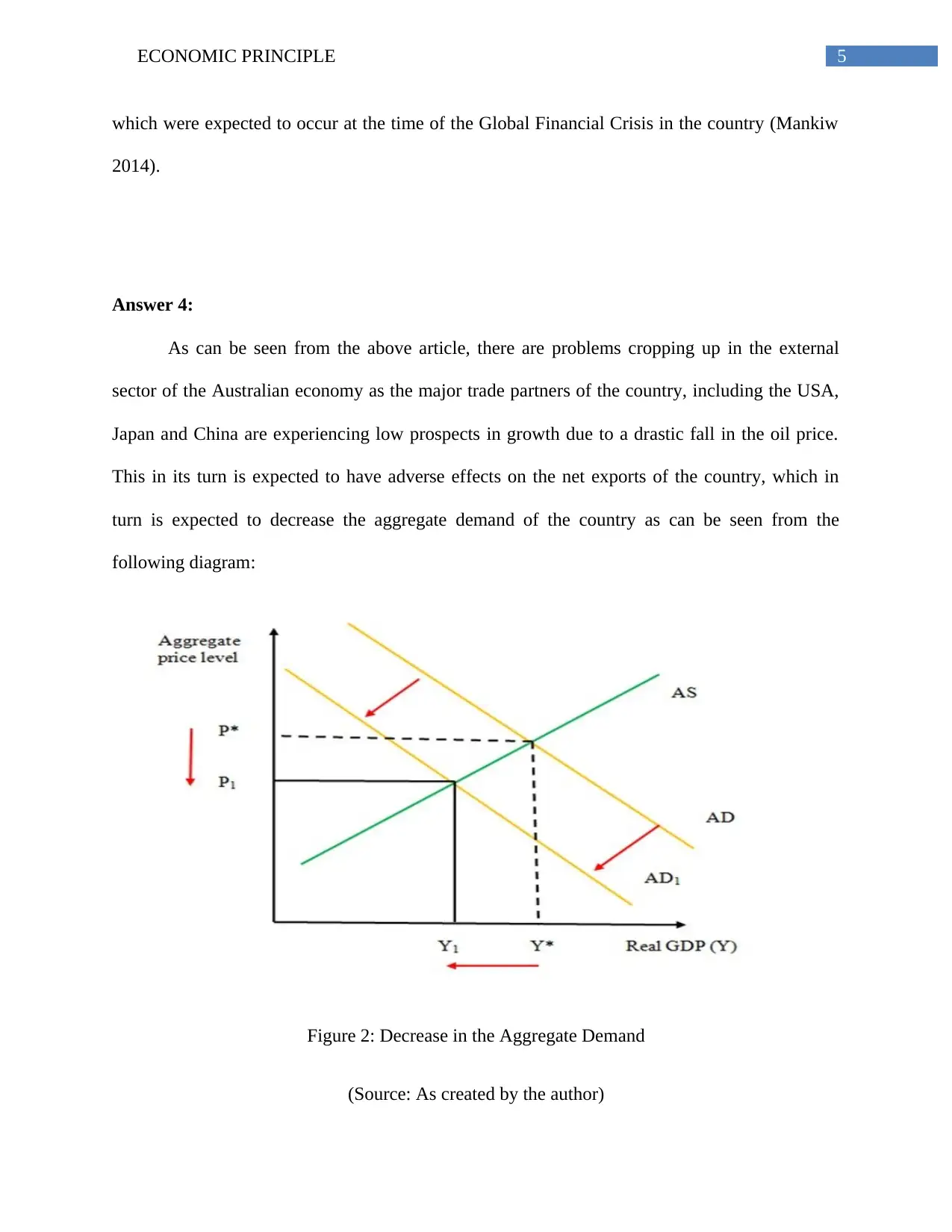
5ECONOMIC PRINCIPLE
which were expected to occur at the time of the Global Financial Crisis in the country (Mankiw
2014).
Answer 4:
As can be seen from the above article, there are problems cropping up in the external
sector of the Australian economy as the major trade partners of the country, including the USA,
Japan and China are experiencing low prospects in growth due to a drastic fall in the oil price.
This in its turn is expected to have adverse effects on the net exports of the country, which in
turn is expected to decrease the aggregate demand of the country as can be seen from the
following diagram:
Figure 2: Decrease in the Aggregate Demand
(Source: As created by the author)
which were expected to occur at the time of the Global Financial Crisis in the country (Mankiw
2014).
Answer 4:
As can be seen from the above article, there are problems cropping up in the external
sector of the Australian economy as the major trade partners of the country, including the USA,
Japan and China are experiencing low prospects in growth due to a drastic fall in the oil price.
This in its turn is expected to have adverse effects on the net exports of the country, which in
turn is expected to decrease the aggregate demand of the country as can be seen from the
following diagram:
Figure 2: Decrease in the Aggregate Demand
(Source: As created by the author)
⊘ This is a preview!⊘
Do you want full access?
Subscribe today to unlock all pages.

Trusted by 1+ million students worldwide
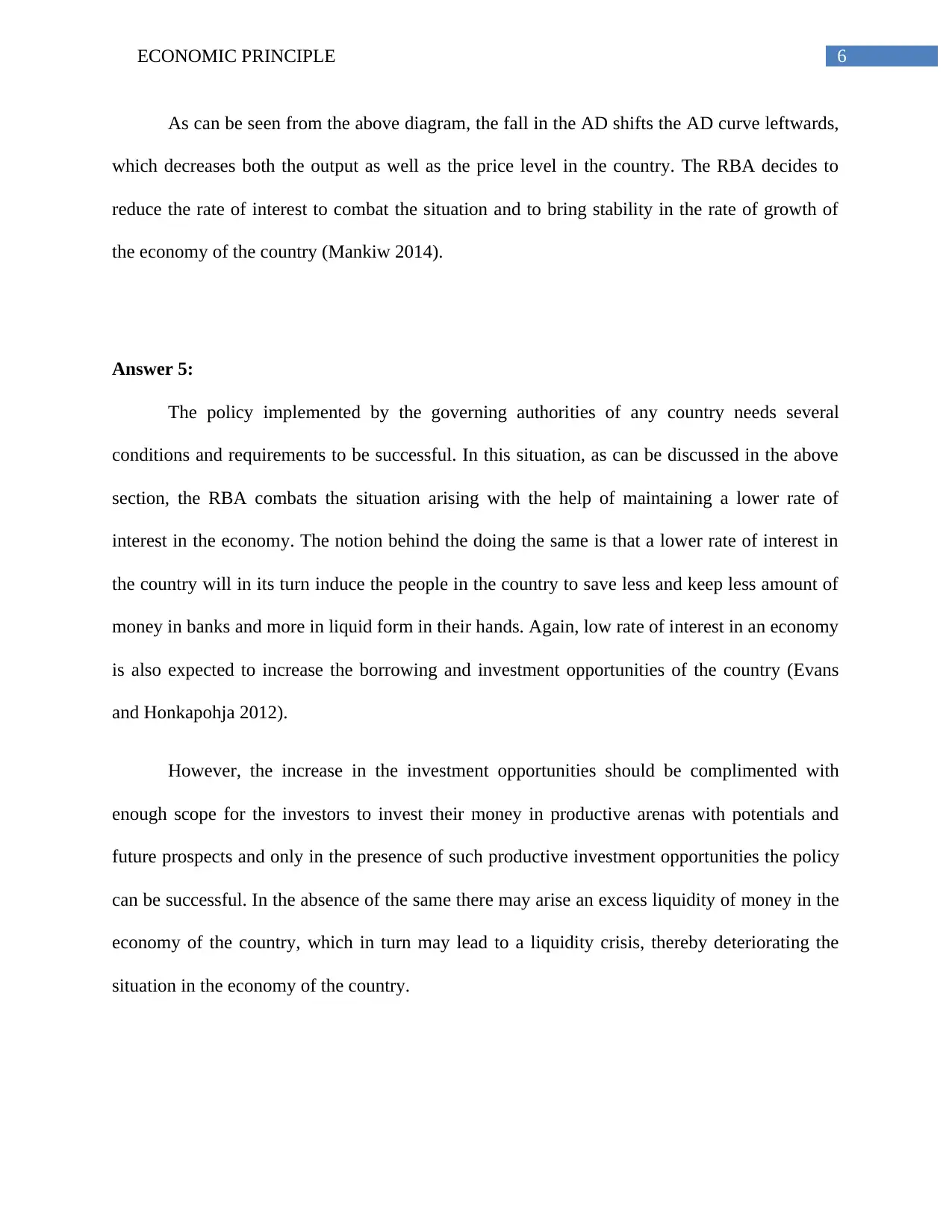
6ECONOMIC PRINCIPLE
As can be seen from the above diagram, the fall in the AD shifts the AD curve leftwards,
which decreases both the output as well as the price level in the country. The RBA decides to
reduce the rate of interest to combat the situation and to bring stability in the rate of growth of
the economy of the country (Mankiw 2014).
Answer 5:
The policy implemented by the governing authorities of any country needs several
conditions and requirements to be successful. In this situation, as can be discussed in the above
section, the RBA combats the situation arising with the help of maintaining a lower rate of
interest in the economy. The notion behind the doing the same is that a lower rate of interest in
the country will in its turn induce the people in the country to save less and keep less amount of
money in banks and more in liquid form in their hands. Again, low rate of interest in an economy
is also expected to increase the borrowing and investment opportunities of the country (Evans
and Honkapohja 2012).
However, the increase in the investment opportunities should be complimented with
enough scope for the investors to invest their money in productive arenas with potentials and
future prospects and only in the presence of such productive investment opportunities the policy
can be successful. In the absence of the same there may arise an excess liquidity of money in the
economy of the country, which in turn may lead to a liquidity crisis, thereby deteriorating the
situation in the economy of the country.
As can be seen from the above diagram, the fall in the AD shifts the AD curve leftwards,
which decreases both the output as well as the price level in the country. The RBA decides to
reduce the rate of interest to combat the situation and to bring stability in the rate of growth of
the economy of the country (Mankiw 2014).
Answer 5:
The policy implemented by the governing authorities of any country needs several
conditions and requirements to be successful. In this situation, as can be discussed in the above
section, the RBA combats the situation arising with the help of maintaining a lower rate of
interest in the economy. The notion behind the doing the same is that a lower rate of interest in
the country will in its turn induce the people in the country to save less and keep less amount of
money in banks and more in liquid form in their hands. Again, low rate of interest in an economy
is also expected to increase the borrowing and investment opportunities of the country (Evans
and Honkapohja 2012).
However, the increase in the investment opportunities should be complimented with
enough scope for the investors to invest their money in productive arenas with potentials and
future prospects and only in the presence of such productive investment opportunities the policy
can be successful. In the absence of the same there may arise an excess liquidity of money in the
economy of the country, which in turn may lead to a liquidity crisis, thereby deteriorating the
situation in the economy of the country.
Paraphrase This Document
Need a fresh take? Get an instant paraphrase of this document with our AI Paraphraser
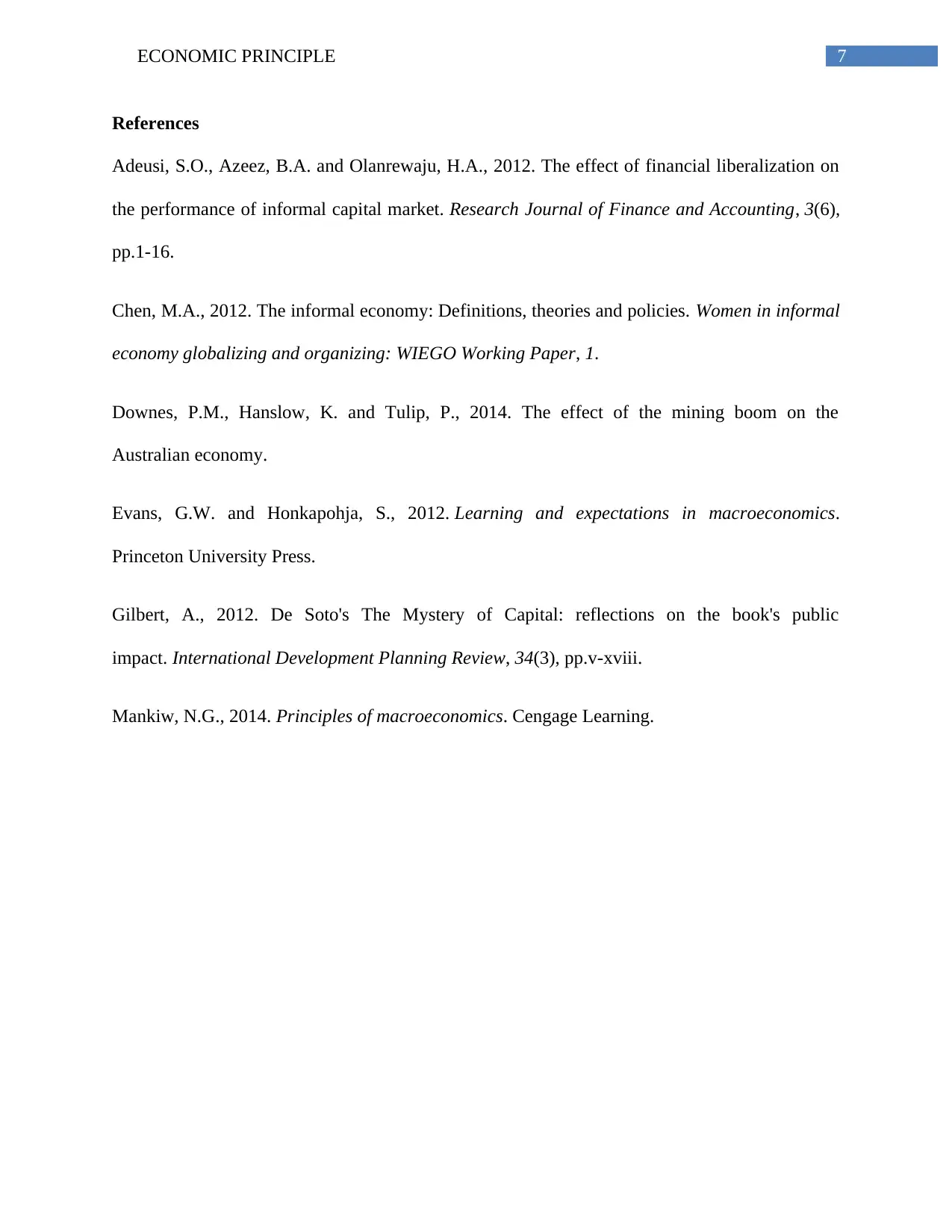
7ECONOMIC PRINCIPLE
References
Adeusi, S.O., Azeez, B.A. and Olanrewaju, H.A., 2012. The effect of financial liberalization on
the performance of informal capital market. Research Journal of Finance and Accounting, 3(6),
pp.1-16.
Chen, M.A., 2012. The informal economy: Definitions, theories and policies. Women in informal
economy globalizing and organizing: WIEGO Working Paper, 1.
Downes, P.M., Hanslow, K. and Tulip, P., 2014. The effect of the mining boom on the
Australian economy.
Evans, G.W. and Honkapohja, S., 2012. Learning and expectations in macroeconomics.
Princeton University Press.
Gilbert, A., 2012. De Soto's The Mystery of Capital: reflections on the book's public
impact. International Development Planning Review, 34(3), pp.v-xviii.
Mankiw, N.G., 2014. Principles of macroeconomics. Cengage Learning.
References
Adeusi, S.O., Azeez, B.A. and Olanrewaju, H.A., 2012. The effect of financial liberalization on
the performance of informal capital market. Research Journal of Finance and Accounting, 3(6),
pp.1-16.
Chen, M.A., 2012. The informal economy: Definitions, theories and policies. Women in informal
economy globalizing and organizing: WIEGO Working Paper, 1.
Downes, P.M., Hanslow, K. and Tulip, P., 2014. The effect of the mining boom on the
Australian economy.
Evans, G.W. and Honkapohja, S., 2012. Learning and expectations in macroeconomics.
Princeton University Press.
Gilbert, A., 2012. De Soto's The Mystery of Capital: reflections on the book's public
impact. International Development Planning Review, 34(3), pp.v-xviii.
Mankiw, N.G., 2014. Principles of macroeconomics. Cengage Learning.
1 out of 8
Related Documents
Your All-in-One AI-Powered Toolkit for Academic Success.
+13062052269
info@desklib.com
Available 24*7 on WhatsApp / Email
![[object Object]](/_next/static/media/star-bottom.7253800d.svg)
Unlock your academic potential
Copyright © 2020–2025 A2Z Services. All Rights Reserved. Developed and managed by ZUCOL.




